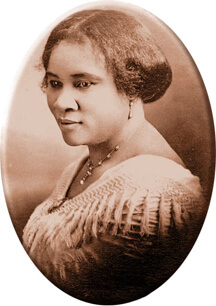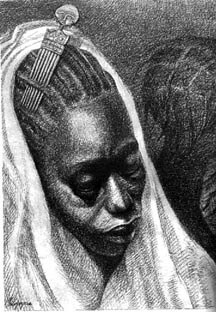Civil Rights
Cornrows were not the only style that African Americans had “rediscovered” in Africa. But while adults' hair was often straightened, children’s hair continued to be a place where the cornrow tradition could be carried on: "Little girls received their first simple pigtails or cornrows at Mother's or Grandmother's knee. Brushing, oiling, and braiding the hair encouraged it to grow." (Peters pp. 9) In the 1950s, the revolts against colonialism in Africa and the stirrings of a new cultural politics in America inspired alternatives to straightening techniques. Black artists, scholars, and activists began to look toward African styles. One of the first to make a trip to Africa was artist John Biggers. He realized that the cornrow styles he had seen growing up in North Carolina were actually survivals of African tradition. South African women in the 1950s were wearing a natural or “bush” style. Jackson (2000) notes that this style begins to appear among Black artists, intellectuals and activists in the mid-1950s. To stress its cultural origins, they called it an “Afro.” Byrd and Tharps describe how Odetta, Nina Simone, Abby Lincoln and others “embraced natural hair and traditional African cornrowed styles” in this era (p. 54). The Afro makes an appearance in Lorraine Hansberry’s 1959 play “A Raisin in the Sun.” Singer Miriam Makeba also gave many Americans their first look at the beauty of African hairstyles.
 After the Civil War, many African Americans began to straighten their hair. Madame C.J. Walker invented
a system for straightening hair without the damage caused by other methods. She became the first black
millionaire, and donated thousands of dollars to the NAACP and similar groups.
After the Civil War, many African Americans began to straighten their hair. Madame C.J. Walker invented
a system for straightening hair without the damage caused by other methods. She became the first black
millionaire, and donated thousands of dollars to the NAACP and similar groups.
 "Even with the advent of the straightening comb in the early 1900s, school girls had their hair braided
and adorned with bangs, barrettes, ribbons, or clothespins. Only on Sundays or special occasions did
younger girls wear their hair loose and curled with hot irons; this hair style requires daily
maintenance unsuited to the activities and schedules of either children or their hard-working mothers"
(Peters 1990, pp. 9).
"Even with the advent of the straightening comb in the early 1900s, school girls had their hair braided
and adorned with bangs, barrettes, ribbons, or clothespins. Only on Sundays or special occasions did
younger girls wear their hair loose and curled with hot irons; this hair style requires daily
maintenance unsuited to the activities and schedules of either children or their hard-working mothers"
(Peters 1990, pp. 9).
 In John Biggers's book of drawings that he published from this trip, he writes: “Many West African hair
styles are worn by Negro women in the United States, including this one— 'cornrows.' The hair is
greased, combed, and tightly plaited. The ends of the hair that fall upon the neck are tied by a string.
The comb has been carved from hard wood” (Biggers pp. 99).
In John Biggers's book of drawings that he published from this trip, he writes: “Many West African hair
styles are worn by Negro women in the United States, including this one— 'cornrows.' The hair is
greased, combed, and tightly plaited. The ends of the hair that fall upon the neck are tied by a string.
The comb has been carved from hard wood” (Biggers pp. 99).
 In 1962 Cicely Tyson appeared on the television series East Side West Side wearing cornrows. By
1969 Black Power was in full swing, and African-roots style had become a mass movement.
In 1962 Cicely Tyson appeared on the television series East Side West Side wearing cornrows. By
1969 Black Power was in full swing, and African-roots style had become a mass movement.